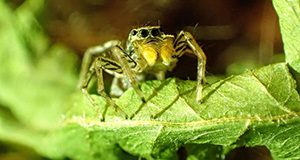Abstract
Maevia inclemens is a common jumping spider found in vines and ivy along tree lines throughout eastern North America. Learn about this interesting and possibly agriculturally beneficial spider in this 3-page fact sheet written by Laurel Lietzenmayer and Lisa Taylor and published by the UF/IFAS Department of Entomology and Nematology.
http://edis.ifas.ufl.edu/in1209
Also available on the Featured Creatures website:
http://entnemdept.ufl.edu/creatures/URBAN/SPIDERS/dimorphic_jumper.html
References
Bradley RA. 2012. Common Spiders of North America. University of California Press. https://doi.org/10.1525/california/9780520274884.001.0001
Busso JP, Rabosky ARD. 2016. "Disruptive selection on male reproductive polymorphism in a jumping spider, Maevia inclemens." Animal Behaviour 120: 1-10. https://doi.org/10.1016/j.anbehav.2016.07.028
Clark DL. 1994. "Sequence analysis of courtship behavior in the dimorphic jumping spider, Maevia inclemens (Araneae, Salticidae)." Journal of Arachnology 22: 94-107.
Clark DL, Biesiadecki B. 2002. "Mating success and alternative reproductive strategies of the dimorphic jumping spider, Maevia inclemens (Araneae, Salticidae)." Journal of Arachnology 30: 511-518. https://doi.org/10.1636/0161-8202(2002)030[0511:MSAARS]2.0.CO;2
Clark DL, Morjan CL. 2001. "Attracting female attention: the evolution of dimorphic courtship displays in the jumping spider Maevia inclemens (Araneae: Salticidae)." Proceedings of the Royal Society of London B: Biological Sciences 268: 2461-2465. https://doi.org/10.1098/rspb.2001.1819
Clark DL, Uetz GW. 1990. "Video image recognition by the jumping spider Maevia inclemens (Araneae: Salticidae)." Animal Behaviour 40: 884-890. https://doi.org/10.1016/S0003-3472(05)80990-X
Clark DL, Uetz GW. 1992. "Morph-independent mate selection in a dimorphic jumping spider: demonstration of movement bias in female choice using video-controlled courtship behaviour." Animal Behaviour 43: 247-254. https://doi.org/10.1016/S0003-3472(05)80220-9
Clark DL, Uetz GW. 1993. "Signal efficacy and the evolution of male dimorphism in the jumping spider Maevia inclemens." Proceedings of the National Academy of Sciences 90: 11954-11957. https://doi.org/10.1073/pnas.90.24.11954
Maloney D, Drummond FA, Alford R. 2003. "Spider predation in agroecosystems: can spiders effectively control pest populations?" Maine Agricultural and Forest Experiment Station, University of Maine, Technical Bulletin No. 190.
Nyffeler M, Olson EJ, Symondson WO. 2016. "Plant-eating by spiders." Journal of Arachnology 44: 15-27. https://doi.org/10.1636/P15-45.1
Ruhren S, Handel S. 1999. "Jumping spiders (Salticidae) enhance the seed production of a plant with extrafloral nectaries." Oecologia 119: 227-230. https://doi.org/10.1007/s004420050780
World Spider Catalog (2017). World Spider Catalog. Natural History Museum Bern, http://wsc.nmbe.ch, version 18.5 (accessed August 2017).
Unless otherwise specified, articles published in the EDIS journal after January 1, 2024 are licensed under a Creative Commons Attribution-NonCommercial-NoDerivs 4.0 International (CC BY-NC-ND 4.0) license.

